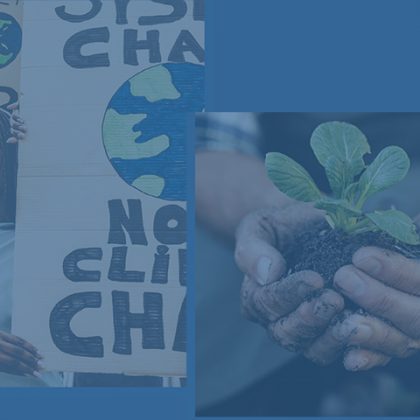Conversations with Authors: Trump and the Shifting Meaning of “Conservative”: Using Activists’ Pairwise Comparisons to Measure Politicians’ Perceived Ideologies
In this “Conversation with Authors,” we spoke with Daniel J. Hopkins and Hans Noel about their timely article, “Trump and the Shifting Meaning of ‘Conservative’: Using Activists’ Pairwise Comparisons to Measure Politicians’ Perceived Ideologies.”
APSR: One of the interesting things about your paper your focus on activists’ perceptions of candidates rather than candidates’ actual positions. How did you get the idea to take this approach?
Hans Noel: A question that keeps me up at a night is: “What is ideology? How do we measure it?” I remember Dan had this idea and said, “Well it’s easier to ask people to do a pairwise comparison than something more complicated—couldn’t we do that?” I think the focus on perception [rather than actual voting record] then came naturally from this approach. If you’re going to do a pairwise comparison, you’re talking about perceptions and impressions instead of measuring [candidates’ ideologies] based off of candidate behavior.
Dan Hopkins: Indeed, and it was a happy coincidence that in the 2016 election we’d teamed up with the Huffington Post, who were surveying activists. Based off prior research by Hans and others, they were attentive to the idea that activists could give us an early clue as to where the parties were moving. So, we had this sample of activists, we had the idea to do pairwise comparisons, and then the question emerged of how well this group would do with pairwise comparisons. In the mass public, you don’t expect a lot of people to have opinions about all fifty senators in their party, so starting with activists seemed like a good place to start.
APSR: What did you find most difficult in researching and writing this letter?
Hans Noel: Finding time to keep everything rolling! We had the idea, we had the data, and we had another project together also using these same data. It seemed pretty straightforward: Come up with a model that takes advantage of pairwise comparisons, compare results over time, compare results to other measures such as DW-NOMINATE scores. But it was still a challenge to keep the ball rolling. We got some early feedback at some conferences, then hit a slow point due to other projects at the time. Bringing the rough ideas together with our early feedback and turning it into an actual paper was especially difficult in the Covid world.
Dan Hopkins: Once we got going, though we struggled to know when we were “done,” in a sense, because there were a variety of interesting directions we could go in with this work, whether that was which perceptions of which senators changed or how could this work generalize. We had three surveys from 2016 and did an additional survey in 2021 to get at some of these outstanding questions. I was encouraged after people heard us or saw an early presentation; people would ask to hear more about this research. There were so many fertile questions we could pursue in this line of work, so the challenge was determining which ones we actually would pursue.
APSR: What did you find most exciting or most surprising about this research?
Hans Noel: As Dan noted, there are so many directions we could take this project, so that in itself is exciting. And we’re still playing around with what else this measurement could be useful for. For me, what was surprising is that we find our activists perceive senators who are associated with Donald Trump as being more conservative than they actually are and perceive senators who take a stand against Trump as being more moderate than their roll call records would suggest. It does make sense that we see a shift in what it means to be conservative, but we thought that would likely be driven by some people more than others, such as Trump supporters versus non-supporters. We had tons of questions asking these activists who they wanted as the 2016 nominee, so we knew who the “Trumpy-activists” were and who weren’t. However, even the people who are not very supportive of Trump still saw and interpreted the same patterns: viewing Trump-aligned senators as more conservative than they actually are.
Dan Hopkins: I would echo everything Hans said. I would also say the experience of writing the letter surprised me, because we were reporting activists’ perceptions of current political figures, which generated some interesting pushback. A local reporter in Philadelphia read the piece and contacted Senator Toomey about our piece. Senator Toomey has a very conservative voting record but also voted for the second impeachment of Donald Trump. As a result of this reporter’s questions about this piece and how our activists rated Toomey’s ideology, Toomey himself came out against the article and defended his conservative record. This raises interesting questions about the meaning of conservatism. This was exciting because there’s a lot of research on elite-level ideology and mass-level ideology, but much less on this perceptual link between the two. A lot of our models of the connection between elite and mass rely on people’s capacity to perceive, especially in a time of nationalized politics.
APSR: Based on your research, do you think that perceptions of elite’s ideology shift regularly, or do you think it’s something more anomalous, because Trump is so unusual? Has Trump shifted what it means to be conservative in such a way that we will no longer return to a world in which conservatism can be removed from Trumpism?
Dan Hopkins: Every indication I have is that certainly the shift persists into 2022. I don’t have any data after April of 2021, but our 2021 survey results – administered after Trump has nominally left the scene – maintain that the most conservative-perceived figures are those who are associated with Donald Trump. If a non-Trump supporting Republican were to be elected, they would be almost as likely to be elected as part of a unity ticket than as part of the Republican Party. I do think, then, that the fault line has shifted to be defined by Trump, by perceptions about the 2020 election results.
Hans Noel: This type of question is exactly what motivates my interest in ideology, generally. My first book on ideology argues that the meaning of liberal and conservative can change all the time, which forces parties to adapt to shifting definitions of ideology. This book focused on political thinkers and writers rather than politicians. So when Trump and Trump-aligned elites started to shift things, this represented a challenge to conservatism and the Republican Party that Trump was the spearhead for. Political thinkers and commentators didn’t lead Trump, they followed Trump. I don’t think this shift is about Trump alone, but Trump is more of a leader than my first book would have predicted a politician to be.
APSR: The midterms are just around the corner. Are there any lessons that people who are interested in the elections can take from this paper to help them think about the midterms?
Dan Hopkins: Every indication from our 2021 survey results and from what we’re seeing in the primaries is that we continue to live in the world that Donald Trump has redefined. What we’re seeing in the primaries this year is a continuation of the patterns our activists picked up on in 2021. Of the House Republicans who voted for impeachment, maybe one will reappear in Congress next year. What our activists picked up on in 2016 and 2021 is not simply the product of Trump in office, though. They pick up what has proven to be a more durable, more meaningful shift in conservatism. This shift incorporates elements of political style and political combat, this idea of “owning the libs,” and even Trump’s particular brand of explicit racial appeal.
Hans Noel: I think Dan’s explanation is really helpful. I step back and look at this from a theoretical standpoint: what is it that we’re really learning? I think we’re learning more about what ideology is and what it’s useful for. As a discipline we are shifting from viewing ideology as simply a bundle of policy positions to something more about symbolic or identity ideology. Our piece fits into this debate because we see changes in what it means to be conservative that seem to be driven more by identity elements than policy elements. At the same time, this doesn’t mean ideology has no coherent policy meaning at all. The other piece of ideology is normative; it’s about principles and philosophical views regarding government. All three of these things interact with each other, and we’re getting at how difficult it is to measure any one of these three facets of ideology. Thinking about the midterms, most voters are not carefully thinking about how these three facets of ideology work together. The people who are making the choices for us, the people voting in primaries and giving us these candidates, are thinking about these facets of ideology. The primary process has been a fight about different perceptions of what and who the Republican and Democratic “teams” is supposed to be for.
APSR: You both mentioned this research brought up several potential avenues of future work. Is there anything you’re pursuing now or would like to pursue in the near future as a result of this research?
Dan Hopkins: Alongside this survey, we also had been asking respondents to try an exercise in which liberal activists made arguments as if they were conservatives and vice versa. We were curious if the liberals who were very politically engaged may be in a position to make arguments like conservatives. Can you tell the difference between an actual liberal discussing minimum wage or abortion and a conservative who trying to make liberal arguments. The problem was that this particular group of activist respondents were knowledgeable enough to provide their opinion on senators’ ideologies, but they themselves are also so ideological that they would rather say horrible things about the other side than actually succeed in this exercise of giving voice to the other side’s arguments. We need to find a way to ask this question that doesn’t lead to trolling.
Hans Noel: Building on Dan’s response, we would have liked to use the answers to this exercise alongside the perceptions of senators’ ideologies to better understand who is truly perceiving this shift in conservatism. Perhaps the people who see the Republican Party and conservative ideology shifting have a better understanding of what liberals think, or a worse understanding of what liberals think. Maybe the ways in which liberals fail to understand conservatism is that they don’t think Trump is a real conservative, or they think he is too much of a real conservative. When we say the meaning of conservatism has changed because it looks more like Trump, there’s evidence of that, but we don’t know how it changed or what the specifics are. We were hoping to get at this using the exercise of asking activists to make arguments for the other side.
– Daniel J. Hopkins, University of Pennsylvania
– Hans Noel, Georgetown University
The authors’ APSR article is free to read until the end of January 2023.




